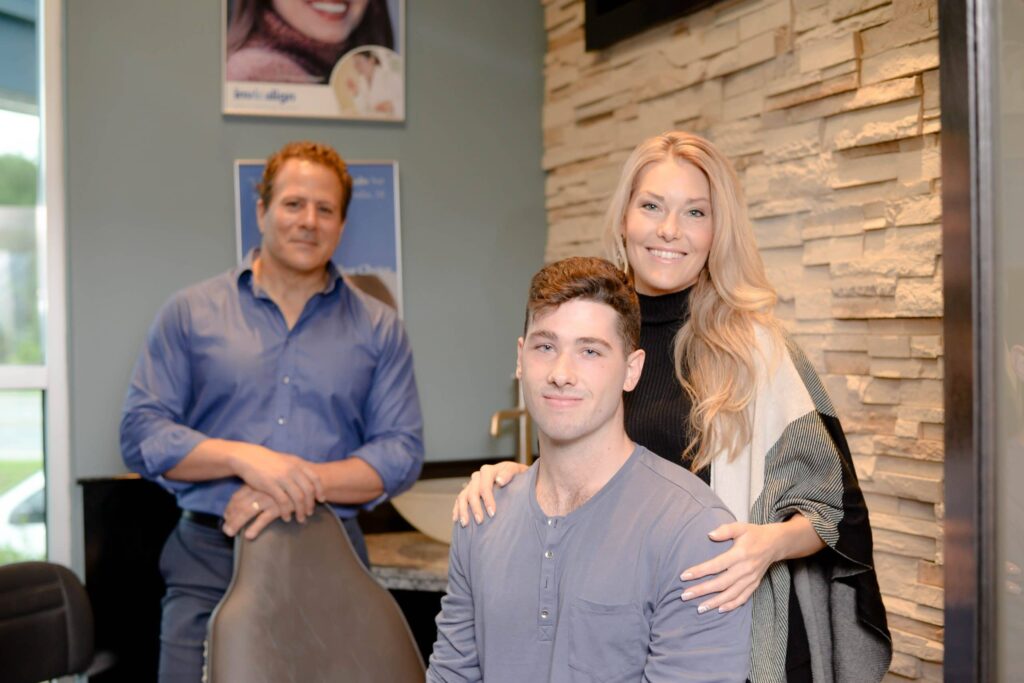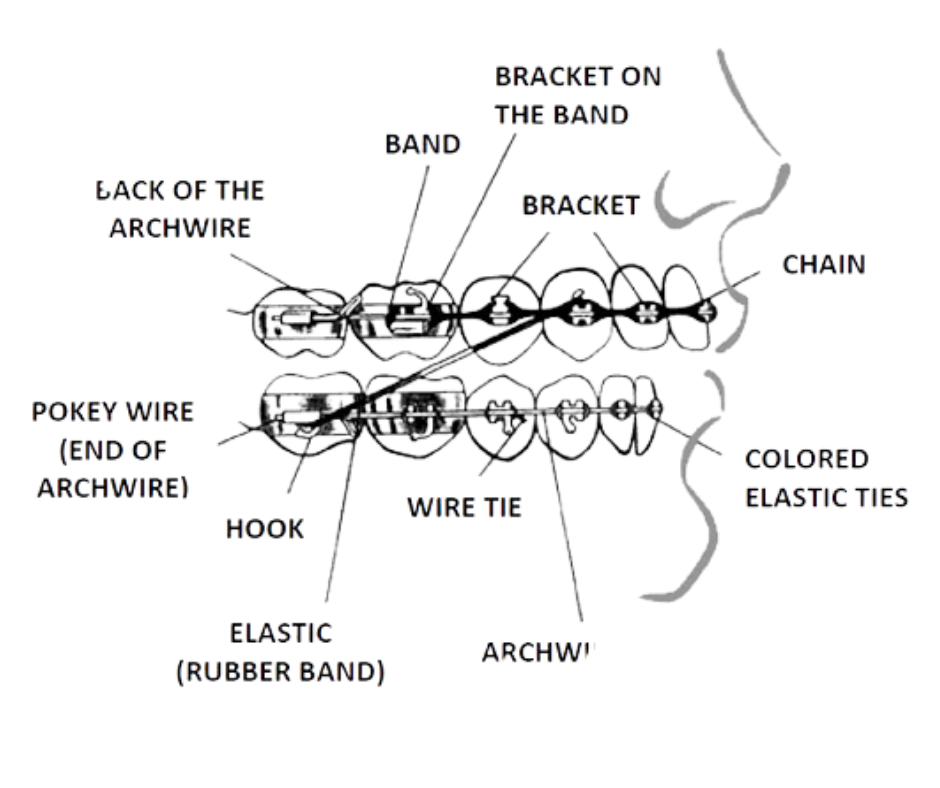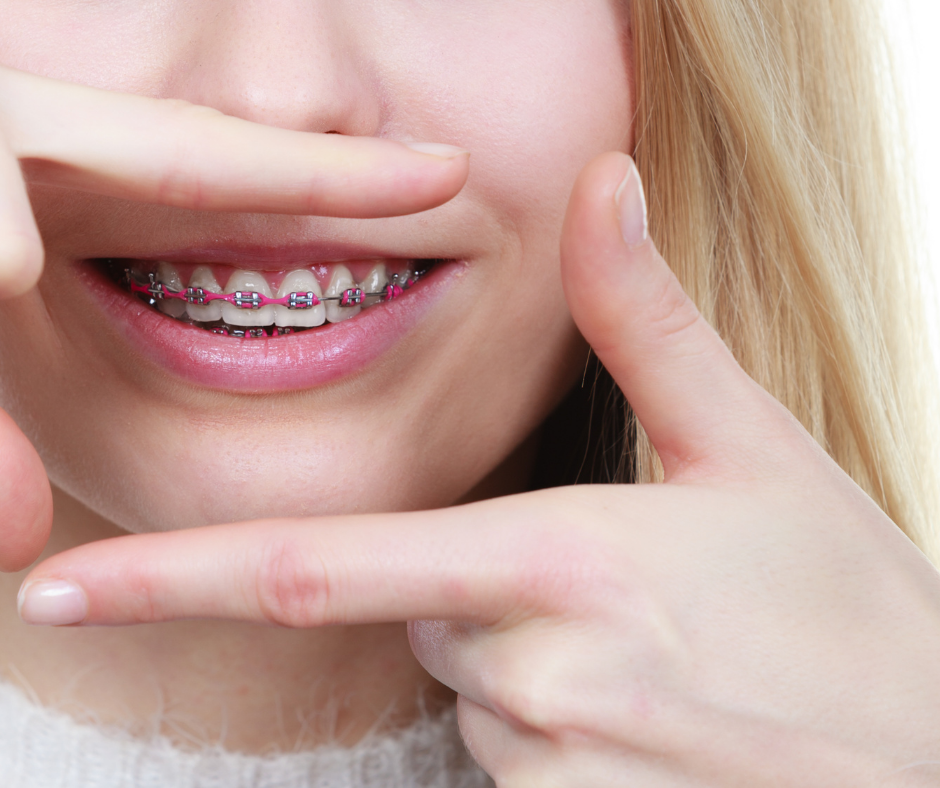Taking Care of Braces

You, your dentist, and your family dentist are now a team. We all want the same things for you, to have a beautiful, healthy smile with straight white teeth. Your orthodontist will straighten your teeth, and your dentist will help keep them clean and check for problems periodically, but you are the one that has to take care of your teeth daily. That means closely following the instructions your orthodontist and orthodontic staff has provided.
Now that you have braces, proper dental care will take a little extra time and effort, but the result will be well worth it. Taking good care of your teeth now ensures that you get the best possible results from your orthodontic treatment.
Parts of your New Braces

Bracket: This component of your braces are the small attachments that are cemented or bonded directly to the
tooth surface. The majority of your teeth will have this type of attachment which can be metal or clear ceramic, it serves as a “handle” on the tooth that the main archwire passes through and provides us a way to grasp and control each individual tooth. When treatment has completed the brackets are removed and the tooth surface is polished free of the cementing materials.
Bands: Occasionally used when a stronger attachment is required to hold the brackets to the tooth surface. These are a thin band of metal, carefully fitted and then cemented in place. The bracket is welded to the band creating a stronger bond required on some molar teeth or situations where the surface of the tooth does not allow the bracket to be attached.
Archwires: These act as a guide or track along which the teeth are to be moved. They are changed throughout the treatment; each change brings us closer to the ideal tooth position.
Rubber Bands: These provide a force that helps teeth move, usually employing one arch or group of teeth against each other. They are not placed at the initial installation appointment but are introduced in the later stages of treatment.
Maintenance of your new Braces

Plaque is the Problem: Plaque is a sticky, colorless film that collects on your teeth. It’s composed of bacteria, food, and saliva. If plaque and trapped food are left on your teeth and around your braces, they can cause swollen gums, bad breath, cavities, and permanent marks on your teeth. Plaque can also discolor your teeth and make them look yellow. To makes sure none of these things happen to your teeth, often brush and floss every day. Also, remember to visit your family dentist regularly for check-ups.
When To Clean

- Brush thoroughly at least 4 times a day: after every meal, and before you go to bed.
- If you can’t brush right away after a meal be sure to at least rinse your mouth with water until you can brush, that way you’ll clear away particles. A travel toothbrush is a great way to make brushing more convenient when you’re at work or school.
- At least once everyday, floss your teeth and then brush your teeth and braces until they are spotless. It is important to floss before you brush because as you floss you will loosen plaque and food between the teeth. You may want to do this before bed because it will take a little extra time and this way you won’t feel rushed.
Orthodontic Brushing
- Use fluoridated toothpaste and a soft-bristle toothbrush that is in good condition. Braces will wear out a toothbrush quickly, so be sure to replace your toothbrush as soon as it shows signs of wear.
- Brush your teeth and braces the way your orthodontist and staff members instructed you to.
- Brush all around all the parts of your braces and every surface of your teeth. Remember to brush the backsides of your teeth, and be sure to brush your tongue. Doing this will not only help to remove food particles from your mouth, but it will also make your breath fresher too.
- Brush your gums gently and thoroughly.
- Rinse thoroughly after brushing. Swish the water all around your mouth and teeth.
- Inspect your teeth and braces carefully to make sure they are spotless. Look closely in a well-lit mirror.
- Remember, they are your teeth, and keep them for the rest of your life, and you need to take good care of them!
Orthodontic Flossing
Flossing is one of the most important parts of taking care of your teeth during orthodontic treatment. To practice good flossing technique, follow these simple directions:
- When flossing with braces on it might be necessary to use what is called a “floss threader”. This reusable tool allows you to get dental floss underneath your archwire easily.
- Cut off about 18 inches of floss and loop it through your threader, run the threader under your archwire between two brackets, and holding one end of the floss, gently pull the threader through.
- Loop the ends of the floss around your index fingers forming a “C” and gently floss between your teeth as you normally would. Make sure to carefully clean along your gum line on both sides. When finished re-thread the floss through the loop and repeat the process between your next pair of teeth.
Flossing with braces on may seem like a difficult process but it is very important, and just like anything else a little practice will make it go a lot faster.
Eating Habits and Orthodontics
A careful orthodontic patient can probably eat almost any food and do no damage to the appliances. However, the following types of food often cause breakage which can delay the progress of the treatment. Use common sense or if you are in doubt don’t hesitate to ask us.
Foods to Avoid
• Hard foods: can bend wires, loosening cement under the bands, or break the brackets.
• Sticky foods: can detach brackets and bend wires.
• Foods high in sugar content: avoid whenever possible. If you do eat any of them, brush your teeth immediately. If not convenient to brush, then always rinse your mouth with water after eating sweets.
Specific foods to avoid
• Popcorn
• Peanuts (nuts in general)
• Corn chips, tacos, nachos
• Caramel, taffy
• Ice
• Corn on the cob
• Bubble gum (or any kind of gum!)
Be careful while eating
- Raw vegetables (i.e. carrot sticks)
- Apples (cut them up first)
- Hard crusty breads (take small bites)
What to do if your Appliance Breaks
Even though you are careful, you may still occasionally do some damage to your appliances. If a bracket comes loose from a tooth you should call our office and our receptionist will advise you if immediate attention is required or if it can be managed at your next appointment. There are a number of measures you can attempt to alleviate discomfort caused by a broken bracket or a poking wire. Consult our website page under Emergency Care. Instructions along with images and videos will help you address the problem until you are able to arrange an appointment. If a main archwire breaks (the one that goes all the way around the outside of your braces) call our office for an emergency appointment. If a small tie wire breaks, carefully remove it and call our office. If you have a sticking wire you can place some wax over the sticker. This wax is provided for you by our office. Any time you need more, just ask. Sometimes a sticker can be safely turned down so that it no longer causes you discomfort. Ask someone at home to take an eraser on a pencil, or some other smooth object and tuck the offending wire back in out of the way.
If you are away from the area, have an orthodontist or dentist cut the little fine wires and take off the band. Keep all the parts and bring them in with you when you come back to our office. If you are involved in contact sports, a regular mouth guard can be fitted over your braces for added protection, and avoid damage to your braces.

